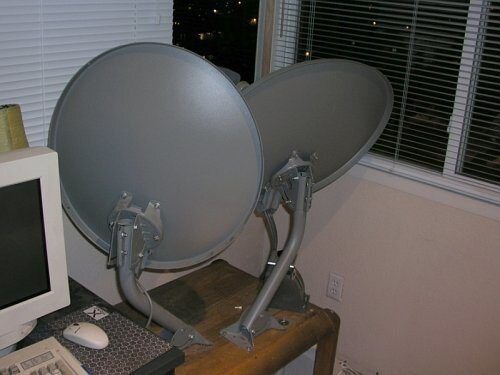What I mean is it, with the physics involved(I have NO clue) for DISH or DIRECTV to make a satellite dish that was CAPABLE of receiving it's info, and be installed inside the house? Pointed out a window, no matter if it was double pane, or whatever the material was. Or if it was even pointed at a wall. It would still get a signal(a very strong one. Over a 100 or better).
The reason I ask is because obviously with the satellite radio's(XM specifically) you can point it at a wall, and still get 100% signal through that wall. I know this because I did it with my XM satellite antenna at one point. I used to point it out near a window(as to there recommendation) toward the southern sky, and got just enough strength to listen.
One day while cleaning I moved it to pointing toward the corner of 2 walls(still in the southern direction, about 4 feet to the left of the window) and the signal came in at 100% from that moment forward. I was like WTF!! It is pointed at a corner of 2 walls and the reception perfect(this is from the satellites, NO GROUND REPEATERS of any kind near me in rural NW Pennsylvania).
Since XM's satellite's is in a FIXED position in the Southern sky(I know it is moving, but it gives the ILLUSION that it is in the same place all the time unlike the moving Sirius birds) which allows for excellent indoor reception.
I switched over to Sirius because of the MUCH BETTER content IMHO and the indoor reception of Sirius is just deplorable. Most people will tell you that Sirius's indoor reception is just BAD, and you really need to place the antenna outside in MOST(not all) situations because of their moving birds.
Now i know that satellite radio is just transmitting compressed AUDIO, and no VIDEO, but are DISH and DirecTV even looking at the possibility of creating a Dish that can be set-up indoors?
Or is it that the science of it, just does not allow it? No matter what you try, when you are sending video and audio(plus other info of course), it just isn't possible to create a Dish for indoor use.
Anyone know if they are trying to develop this or someone is trying to develop this?
The reason I ask is because obviously with the satellite radio's(XM specifically) you can point it at a wall, and still get 100% signal through that wall. I know this because I did it with my XM satellite antenna at one point. I used to point it out near a window(as to there recommendation) toward the southern sky, and got just enough strength to listen.
One day while cleaning I moved it to pointing toward the corner of 2 walls(still in the southern direction, about 4 feet to the left of the window) and the signal came in at 100% from that moment forward. I was like WTF!! It is pointed at a corner of 2 walls and the reception perfect(this is from the satellites, NO GROUND REPEATERS of any kind near me in rural NW Pennsylvania).
Since XM's satellite's is in a FIXED position in the Southern sky(I know it is moving, but it gives the ILLUSION that it is in the same place all the time unlike the moving Sirius birds) which allows for excellent indoor reception.
I switched over to Sirius because of the MUCH BETTER content IMHO and the indoor reception of Sirius is just deplorable. Most people will tell you that Sirius's indoor reception is just BAD, and you really need to place the antenna outside in MOST(not all) situations because of their moving birds.
Now i know that satellite radio is just transmitting compressed AUDIO, and no VIDEO, but are DISH and DirecTV even looking at the possibility of creating a Dish that can be set-up indoors?
Or is it that the science of it, just does not allow it? No matter what you try, when you are sending video and audio(plus other info of course), it just isn't possible to create a Dish for indoor use.
Anyone know if they are trying to develop this or someone is trying to develop this?


